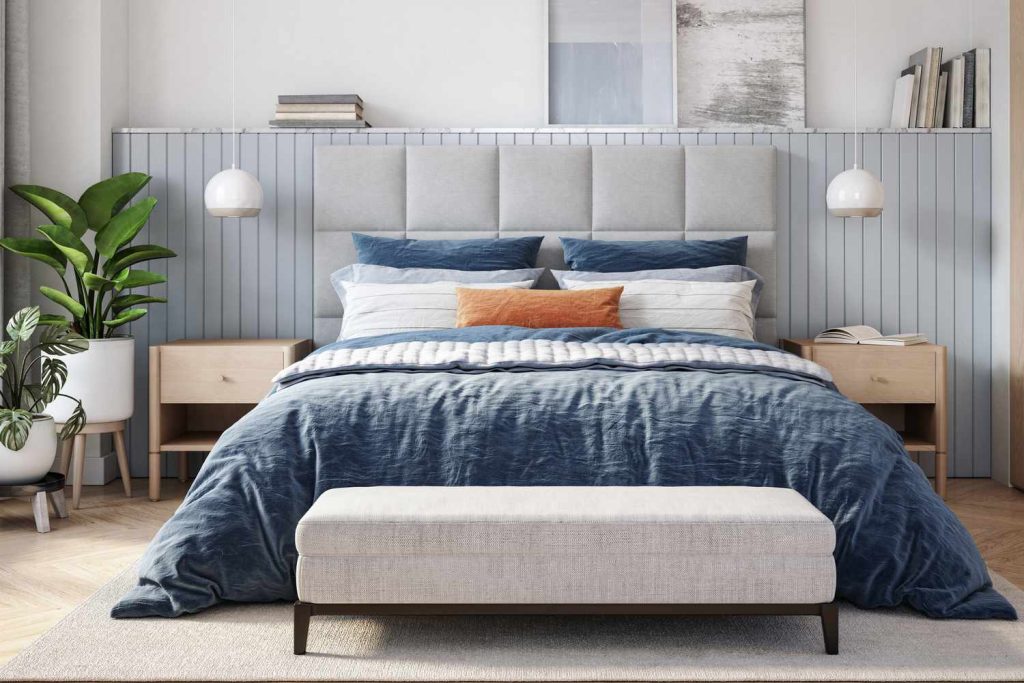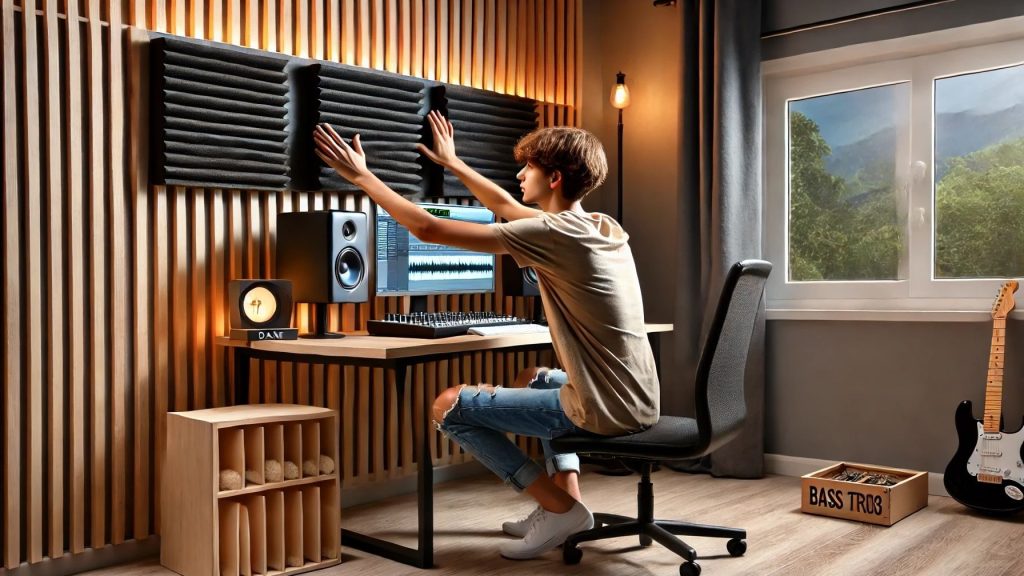Noise can be a big problem whether you work from home, record music, or run a business that needs privacy. Building a soundproof room doesn’t have to cost a fortune. In this guide, we’ll show you how to soundproof a room on a budget using simple materials and smart planning perfect for homes, studios, or offices.
Why Soundproofing is Important
Soundproofing improves comfort, focus, and privacy. For businesses, it also makes your space look more professional.
Main benefits include:
- Better focus and less distraction
- Clearer communication during meetings
- Higher sound quality for recordings
- Improved client experience
- Adds property value
How Soundproofing Works
Soundproofing means blocking or absorbing sound so it doesn’t pass through walls, floors, or ceilings.
The Four Key Rules of Soundproofing:
- Add mass: Heavy materials block sound.
- Seal gaps: Sound travels through even the smallest holes.
- Absorb sound: Soft materials reduce echoes.
- Separate layers: Prevent vibration transfer between walls.
Understanding these basics helps you plan even a low-cost soundproof room effectively.
| Step | What to Do | Why It Helps | Approx Cost Tips & Notes |
| 1. Choose the right room | Use a room with fewer shared walls, fewer windows | Less work needed if you start with a favorable room | Avoid corners or rooms against busy streets |
| 2. Seal all gaps, cracks, and joints | Use caulk, silicone, weatherstripping around doors, windows, outlets, vents | Sound leaks ruin your efforts | This is one of the most cost-effective steps |
| 3. Add soundproof curtains or heavy drapes | Thick, dense curtains absorb / block some sound | Especially over windows and doors | You can find heavy blankets or “moving blankets” to repurpose |
| 4. Use “mass loaded vinyl” (MLV) or heavy vinyl sheets | It adds mass to walls, helping block lower frequency sounds | You can install it behind drywall or under panels | In small rooms, even a partial coverage helps |
| 5. Add drywall (double layer) with damping compound | A second layer of drywall separated by a thin damping layer (e.g. Green Glue or another compound) helps | More mass + damping works well | You can use cheaper alternatives if Green Glue is costly |
| 6. Build a “room within a room” (or “floating wall”) | Decouple the inner structure from outer walls via resilient channels or isolation clips | Reduces vibration transfer | This is more advanced; try simpler methods first |
| 7. Acoustic panels, foam, or insulation | Use mineral wool, rock wool, fiberglass, or acoustic foam panels | Helps absorb reflections, echoes, and reduces inside noise | You might DIY panels with wood frame + insulation + fabric |
| 8. Treat floor and ceiling | Use carpet, thick rug, underlayments, ceiling baffles, acoustic ceiling tiles | Sound travels through floor and ceiling too | If there is a room below or above, this is important |
| 9. Door upgrades | Use solid core doors, add door sweeps, seals, extra layer of wood or mass | Doors are frequent weak points | You can also build a “door plug” (a removable dense panel to place over door when needed) |
| 10. Ventilation and HVAC | Keep airflow but isolate noise with duct silencers, bends, acoustic ducts | You need ventilation in a closed room | Use flexible ducts and acoustic liners |
Step 1: Pick the Right Room
Start with the quietest area possible.
- Choose a room away from traffic or noisy streets.
- Avoid rooms with too many windows.
- Basements or internal rooms are often best.
The fewer sound leaks you have, the less you’ll spend later.
Step 2: Seal All Cracks and Gaps
Before buying expensive materials, seal every hole and crack.
Use acoustic sealant or silicone caulk around doors, windows, and electrical outlets.
Add weatherstripping on doors and window frames.
Check vents and ducts for noise leaks.
This simple step can cut noise by 20–30% and costs very little.
Step 3: Cover Windows and Doors
Windows and doors are the weakest points in any room.
- Hang heavy soundproof curtains or thick blankets.
- Add door sweeps to block the gap under the door.
- Install foam seals around the door edges.
- Use a solid-core door if possible.
You can also add double glazing or a second acrylic sheet for windows to reduce outside noise.

Step 4: Add Mass to Walls (Low Cost Ways)
Adding mass helps stop sound waves. You don’t need to rebuild the walls just add layers.
Try these budget-friendly ideas:
- Use mass loaded vinyl (MLV) flexible sheets that block sound.
- Add a second layer of drywall using Green Glue or similar damping material.
- Use wooden panels or fiber boards for extra thickness.
If you can’t afford full coverage, focus on walls facing the noise source.
Step 5: Install DIY Acoustic Panels
Acoustic panels absorb sound inside the room and reduce echo.
You can make your own panels easily:
- Build a simple wooden frame.
- Fill it with rockwool or foam insulation.
- Cover it with breathable fabric.
Mount these panels on walls at ear level or first reflection points for best results.
They also improve your room’s appearance perfect for offices or studios.
Step 6: Treat the Ceiling and Floor
Sound can also travel through ceilings and floors.
- Add carpet, thick rugs, or underlays to absorb footstep noise.
- Use acoustic ceiling tiles or baffles to absorb echo.
- In multi-floor buildings, use foam mats under flooring.
Even small upgrades can make a big difference in reducing echo.
Step 7: Use Household Materials (Budget DIY Hacks)
You don’t always need to buy new products.
Here are some cheap soundproofing hacks:
- Hang moving blankets or old mattresses against noisy walls.
- Stack bookshelves full of books for added wall mass.
- Use egg cartons or foam sheets to absorb reflections (temporary fix).
- Roll up towels or cloth to seal gaps under doors.
These methods are not professional-grade but still improve quietness without spending much.
Step 8: Manage Air Vents and Ducts
Sound often escapes through air vents.
To fix this:
- Use acoustic foam or bent duct designs to block sound waves.
- Add vent silencers if possible.
- Avoid sealing completely airflow is important for comfort.
Step 9: Focus on Weak Spots First
If you’re working with a small budget, start with the biggest problems:
- Door and window sealing
- Gaps and outlets
- Basic wall and floor treatments
Once those are improved, move to more advanced solutions like double drywall or isolation clips.
When to Call a Professional
DIY works for small rooms, but large projects like conference rooms, studios, or cinemas need expert design.
A professional soundproofing company like SoundKrafted can:
- Analyze noise sources
- Recommend right materials
- Design acoustic layouts
- Ensure proper installation
Professional guidance saves time and ensures lasting results.
Common Mistakes to Avoid
- Using thin foam for blocking noise (foam only absorbs echoes)
- Ignoring door or window gaps
- Forgetting ceiling and floor noise paths
- Making the room airtight with no ventilation
- Overlooking vibration from furniture or equipment
Final Thoughts
Building a soundproof room on a budget is totally possible with smart planning. Start small seal gaps, use heavy curtains, and add DIY acoustic panels. Then upgrade step by step as your budget allows.
You’ll notice huge improvements in comfort, productivity, and peace.
Need Expert Help?
At SoundKrafted, we specialize in acoustic and soundproofing solutions for:
- Offices and meeting rooms
- Recording studios
- Home theaters
- Restaurants and cafés
We offer affordable custom soundproofing using high-quality materials, tested designs, and professional installation.
Visit soundkrafted.com
to learn more or request a free consultation.

